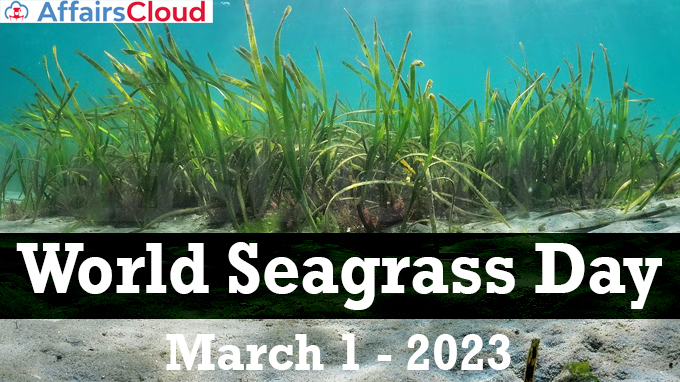 United Nations (UN)’s celebrated the 1st ever World Seagrass Day across the globe on 1st March 2023. The day is observed to raise awareness of the importance of seagrass as a core component of marine biodiversity, the threats they face, and their contribution to sustainable development and climate change mitigation and adaptation.
United Nations (UN)’s celebrated the 1st ever World Seagrass Day across the globe on 1st March 2023. The day is observed to raise awareness of the importance of seagrass as a core component of marine biodiversity, the threats they face, and their contribution to sustainable development and climate change mitigation and adaptation.
Aim:
The aim of World Seagrass Day is to raise public awareness of the threats to these ecosystems and to encourage their conservation, which is essential for achieving the SDGs and the Paris Climate Agreement.
Background:
i. The United Nations General Assembly (UNGA) adopted the resolution A/RES/76/265 on 23rd May 2022 and proclaimed March 1 of every year as World Seagrass Day.
ii. The resolution emphasises the urgent need to increase awareness at all levels, promote, and facilitate actions for seagrass conservation to support their growth and health, keeping in mind that improving ecosystem services and functions is important for achieving the Sustainable Development Goals (SDGs).
Significance:
On 1st March 2023, as part of the 1st-ever World Seagrass Day celebration, the UN called for more action to protect one of the earth’s most extensive and significant marine ecosystems.
Seagrass:
i. Around 300,000 square kilometres of the ocean floor are covered by seagrasses, which are marine flowering plants (angiosperms) that can be found in shallow waters from the tropics to the Arctic Circle.
ii. It is not as vibrant as coral reefs or as enigmatic as mangrove forests. They provide a wide range of benefits to humans and marine life
iii. The world’s largest fisheries are supported by seagrass meadows, which are often referred to as a type of “blue forest” and provide food and shelter to countless fish, seahorses, turtles, and other marine animals.
iv. Seagrasses are also important to non-marine animals, including geese and ducks that graze on seagrasses during their autumn migration.
v. Seagrasses enhance water quality by filtering, cycling, and storing nutrients and pollutants, lowering seafood contamination.
- They store up to 18% of the world’s oceanic carbon as part of the marine ecosystem.
Seagrass- Risk Factor:
i. Since the 1930s, seagrasses have been declining on a global scale. According to the most recent census, 7% of this important marine habitat is being lost annually.
ii. According to the International Union for Conservation of Nature’s Red List of Threatened Species, 21% of seagrass species are classified as Near Threatened, Vulnerable, or Endangered Species.
About the United Nations (UN):
Secretary-General- António Guterres
Headquarters- New York, USA
Establishment- 1945




